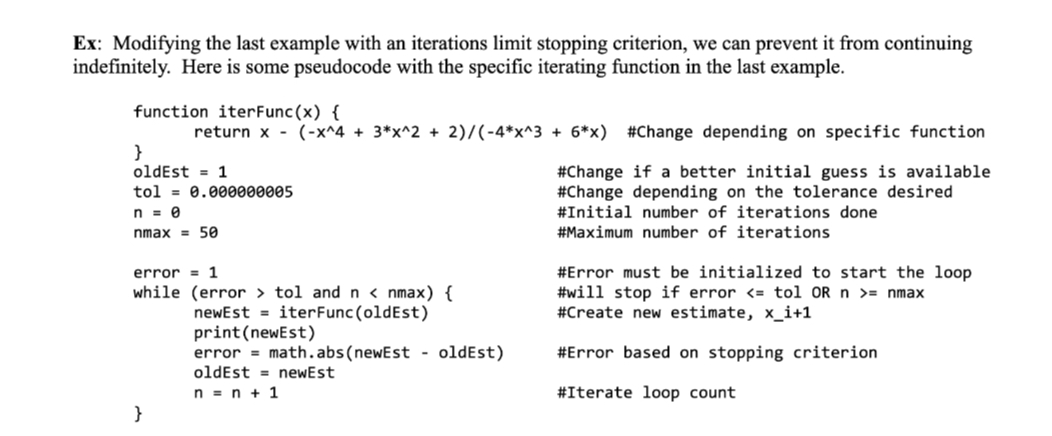include all of the code for these problems in the HW you turn in, as most of it will j 5. However, write down the first 5 to 8 lines (depending on the language used) that the initial guess, and the tolerance, along with the roots found in the end. For the ing utility, graph the function and get three initial guesses, one for each root. They tegers necessarily. code from Exercise 5 (three times) to find the solutions to the equations to within 8 You may need to import a math library to evaluate some functions. If an initial guess you already found, use a different initial guess visually closer to the root you're tryin
include all of the code for these problems in the HW you turn in, as most of it will j 5. However, write down the first 5 to 8 lines (depending on the language used) that the initial guess, and the tolerance, along with the roots found in the end. For the ing utility, graph the function and get three initial guesses, one for each root. They tegers necessarily. code from Exercise 5 (three times) to find the solutions to the equations to within 8 You may need to import a math library to evaluate some functions. If an initial guess you already found, use a different initial guess visually closer to the root you're tryin
Database System Concepts
7th Edition
ISBN:9780078022159
Author:Abraham Silberschatz Professor, Henry F. Korth, S. Sudarshan
Publisher:Abraham Silberschatz Professor, Henry F. Korth, S. Sudarshan
Chapter1: Introduction
Section: Chapter Questions
Problem 1PE
Related questions
Question

Transcribed Image Text:5) Rewrite the pseudocode for Newton's method in the notes in C++, Java, or Python. Include the iterations
limit stopping criterion. Test it by using the same function, ƒ(x)= x³ + x − 1, initial guess, x = 0, and
tolerance, 0.00005. In the next few exercises you will change these lines to find roots of different functions.
Include your rewritten code in the HW you turn in.
6-7) You do not need to include all of the code for these problems in the HW you turn in, as most of it will just
be the same as number 5. However, write down the first 5 to 8 lines (depending on the language used) that
define the function used, the initial guess, and the tolerance, along with the roots found in the end. For the
following equations,
(a) using a graphing utility, graph the function and get three initial guesses, one for each root. They do
not need to be integers necessarily.
(b) modify your code from Exercise 5 (three times) to find the solutions to the equations to within 8
decimal places. You may need to import a math library to evaluate some functions. If an initial guess
gives you a root you already found, use a different initial guess visually closer to the root you're trying
to find.
6) 2x² - 6x = 1
7) ex-2=x-x³
Expert Solution
Step 1

Step by step
Solved in 3 steps with 3 images

Knowledge Booster
Learn more about
Need a deep-dive on the concept behind this application? Look no further. Learn more about this topic, computer-science and related others by exploring similar questions and additional content below.Recommended textbooks for you

Database System Concepts
Computer Science
ISBN:
9780078022159
Author:
Abraham Silberschatz Professor, Henry F. Korth, S. Sudarshan
Publisher:
McGraw-Hill Education

Starting Out with Python (4th Edition)
Computer Science
ISBN:
9780134444321
Author:
Tony Gaddis
Publisher:
PEARSON

Digital Fundamentals (11th Edition)
Computer Science
ISBN:
9780132737968
Author:
Thomas L. Floyd
Publisher:
PEARSON

Database System Concepts
Computer Science
ISBN:
9780078022159
Author:
Abraham Silberschatz Professor, Henry F. Korth, S. Sudarshan
Publisher:
McGraw-Hill Education

Starting Out with Python (4th Edition)
Computer Science
ISBN:
9780134444321
Author:
Tony Gaddis
Publisher:
PEARSON

Digital Fundamentals (11th Edition)
Computer Science
ISBN:
9780132737968
Author:
Thomas L. Floyd
Publisher:
PEARSON

C How to Program (8th Edition)
Computer Science
ISBN:
9780133976892
Author:
Paul J. Deitel, Harvey Deitel
Publisher:
PEARSON

Database Systems: Design, Implementation, & Manag…
Computer Science
ISBN:
9781337627900
Author:
Carlos Coronel, Steven Morris
Publisher:
Cengage Learning

Programmable Logic Controllers
Computer Science
ISBN:
9780073373843
Author:
Frank D. Petruzella
Publisher:
McGraw-Hill Education